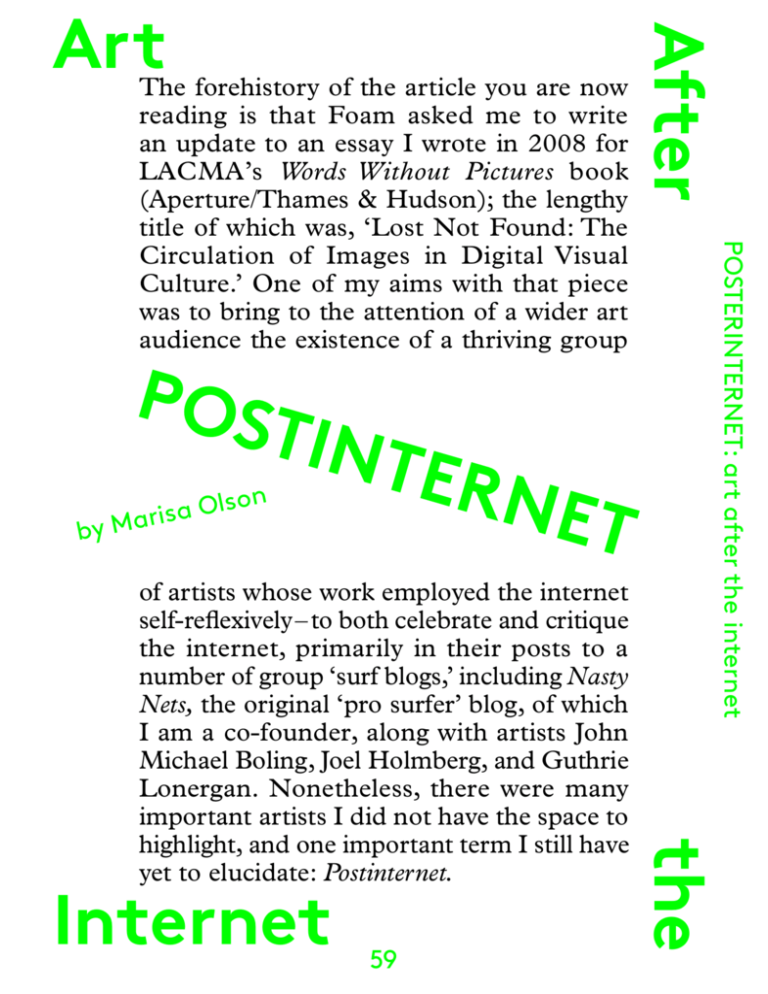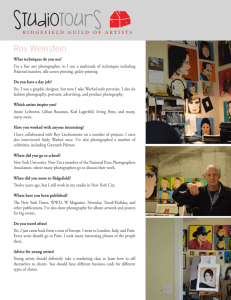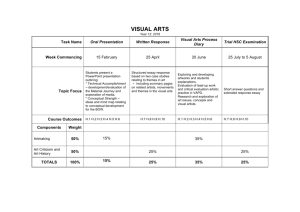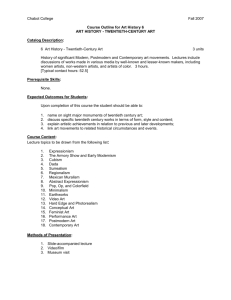Art Internet A fter the
advertisement

P OS TINT son l O a s i r by Ma ERN ET Internet 59 the of artists whose work employed the internet self-reflexively – to both celebrate and critique the internet, primarily in their posts to a number of group ‘surf blogs,’ including Nasty Nets, the original ‘pro surfer’ blog, of which I am a co-founder, along with artists John Michael Boling, Joel Holmberg, and Guthrie Lonergan. Nonetheless, there were many important artists I did not have the space to highlight, and one important term I still have yet to elucidate: Postinternet. POSTERINTERNET: art after the internet The forehistory of the article you are now reading is that Foam asked me to write an update to an essay I wrote in 2008 for LACMA’s Words Without Pictures book (Aperture/Thames & Hudson); the lengthy title of which was, ‘Lost Not Found: The Circulation of Images in Digital Visual Culture.’ One of my aims with that piece was to bring to the attention of a wider art audience the existence of a thriving group After Art In his recent essay, ‘Within Post-Internet’ (pooool. info, 2011), Louis Doulas sets the scene: ‘While Post-Internet is a term still awkwardly vague to many, it was first conceived by artist Marisa Olson, most widely encountered in a 2008 interview conducted through the website We Make Money Not Art. Her definition acknowledges that internet art can no longer be distinguished as strictly computer/internet based, but rather, can be identified as any type of art that is in some way influenced by the internet and digital media.’ from here on(line) While there has now been a fair amount of writing about the term, and a fair number of artists, curators, and scholars have clung to it, I have yet to publish a statement of my own outlining what I meant in coining the term ‘Postinternet Art,’ and how I’ve seen it develop in the five years since I did so. This will be that essay. The p a con ostintern e quali dition, a t is a mo m fact, p t I want is to give you a historiography that t,what trans y that en roperty, eInisnaware of the conditions of its own production, as I a a cend c present you with an image philosophy of s new ompasse ndsimultaneously art influenced by the internet. s an medi d a. My original statement to We Make Money Not Art’s Régine Debatty was that ‘I think it’s important to address the impacts of the internet on culture at large, and this can be done well on networks but can and should also exist offline.’ This is a point that I’d been trying to hammer-home to anyone who cared to listen for the previous 3-4 years. When appointed Editor & Curator at Rhizome, in 2005, my first agenda was to change the organization’s mission statement to assert its support of not only internet-based art, but all art that engages with the internet. I tried, in the essay ‘Lost Not Found’, to pry existing conversation about this work away from the oversimplified, often dismissive diagnosis of pro-surfer work as a mutant digital strain of that genre silhouetted by the phrase ‘found photography,’ and hold this work up against other notions about the ways in which quotidian content circulates within the space of flows we know as the net. As I said there, these Pro Surfers are ‘engaged in an enterprise distinct from the mere appropriation of found photography. They present us with constellations of uncannily decisive moments, images made perfect by their imperfections, images that add up to portraits of the web, diaristic photo essays on the part of the surfer, and images that certainly add up to something greater than the sum of their parts. Taken out of circulation and repurposed, they are ascribed with new value, like the shiny bars locked up in Fort Knox.’ The theoretical ‘money shot’ of the essay resided in my statement that ‘the work of pro-surfers transcends the art of found photography insofar as the act of finding is elevated to a performance in its own right, and the ways in which the images are appropriated distinguishes this practice from one of quotation by taking them out of circulation and reinscribing them with new meaning and authority.’ Nonetheless, there were many important artists I did not have the space to highlight, and one important term I still have yet to elucidate: Postinternet. Shortly afterwards, Rhizome Executive Director Lauren Cornell invited me to join her on a net art panel at Electronic Arts Intermix (EAI) that also included artists Cory Arcangel, Michael Bell-Smith, and Wolfgang Staehle, and curators Michael Connor and Caitlin Jones as respondents. The panel was preceded by Time Out-NY’s [2006] publication of a roundtable discussion among us artists about the state of net art practice. In both the article and live discussion, I made the point that I felt what I was making was ‘art after the internet.’ Pressed for an explanation, at the panel, I said that both my online and offline work was after the internet in the sense that ‘after’ can mean both ‘in the style of’ and ‘following.’ For illustration, I referred to the concept of postmodernity coming not at the end of modernity, but after (and with a critical awareness of) modernity. 60 I’m not the only person to have discussed concepts similar to the postinternet. Indeed, Guthrie Lonergan spoke in a 2008 Rhizome interview with curator Thomas Beard of ‘internet aware art,’ which he described as a way ‘to take the emphasis off the internet and technology, but keep my ideas [about them] intact.’ Interestingly, this compelled him to make what he called ‘Objects that aren’t objects,’ i.e. a t-shirt or a book whose primary purpose is to be the vehicle of internet content. In 2009, curator Gene McHugh was awarded a Warhol Foundation Arts Writers Grant to keep an ambitious blog (recently published in paperback format by LINK Editions) called Post Internet, which took my term and Lonergan’s as points of departure in critiquing and historically-contextualizing contemporary work that might be considered postinternet. McHugh sees the postinternet situation as one in which ‘the internet is less a novelty and more a banality,’ a presence that is now a given; a generally less phenomenal phenomenon. artists, and others began writing about their own take on the term, as in Artie Vierkant’s ‘The Image Object Post-Internet,’ whose own salient definition of the term calls it ‘a result of the contemporary moment: inherently informed by ubiquitous authorship, the development of attention as currency, the collapse of physical space in networked culture, and the infinite reproducibility and mutability of digital materials.’ These are all tell-tale network conditions that have both pre-internet precursors and contemporary offline manifestations; furthermore, this historically-aware, continuum-synthesizing definition of the postinternet is itself exemplary of postinternet thought, insofar as it reflects this awareness. Certainly, art history is not without its Posts. We’ve managed to solder this recursive prefix onto a number of names for movements and practices within the field at large. Whether we speak of the postmodern or the postphotographic, when we pop a ‘post’ on the front end of a thing, we place a priority on priorness. But the time-delay between the conjoined terms should be measured in the context of the near-future, not a vast remove. Afterall, looking at a histogram of the forms and ideas that have influenced art practice and its discourses, postmodernity may now sit much closer to modernity than it does to us today. Just ask Bourriaud: postmodernity is dead, long live altermodernity! I lay out the history of this discussion in this way for several reasons. I feel that it is important to be selfaware and transparent while one plows forward with the work of articulating a set of practices and communities greater than herself. This essay is an open work and I can only aspire to be what Rancière might call an Ignorant Historiographer. I also feel that postinternet artistic practices (as opposed to everyday postinternet material culture) have not only a special kind of relevance or currency, but that they are also part and parcel of an as-yet unspoken, totalizing, near-universal set of conditions that applies to all art as much as it implicates all art in transporting the network conditions under which we live. This is a brisk responsibility ripe with opportunity, though many artists will undoubtedly fail or elect not to recognize and exercise it. But the final, if not the most obvious reason to be metaenunciative in sketching this historiography is that no observer of a post-epoch can tell you precisely when they arrived there, only where they arrived. No one can tell you what they ate for lunch on the day that ‘postinternetism’ struck, or what shoes they were wearing when the big news dropped. With the exception of 9/11, there is no degree-zero for this or any other post-epoch, only a categorical here-and-now that will persist until it doesn’t; until it becomes stale and the air smells of another mode. If it weren’t so stale to speak of paradigm change, one would here invoke Thomas Kuhn… Far more interesting than the life and death of this nomenclature are the changes to which they bear witness. To call a thing a post-thing is to say that the thing is itself precisely because of the thing. We could quite exhaustively consider the ways in which my postmodern sweatshirt is postmodern (beginning at the very least with the conditions of its production and not ending before irony), but the ‘post-’ says it all. Because of the modern conditions of which my sweatshirt transports a critical awareness, my sweatshirt is postmodern. Propter hoc ergo post hoc. 61 The notion of the postinternet encapsulates and transports network conditions and their critical awareness as such, even so far as to transcend the internet. The expectation of ‘afterness’ preempts the root of the post- POSTERINTERNET: art after the internet et n r e t tin s o p r ts o e p h s t f an ical o r t n o d i ot an rit n s c e e r t i h e a T to th sul s d p a n a r c a fa s en n o . o s t i e t n i n e d r v con such, e the inte k r o netw eness as anscend r tr Meanwhile, artists like Harm van denaDorpel wabegan identifying themselves in their bios as postinternet thing, as a sort of simultaneously taxonomic/ taxidermic lacquer is poured over ‘the modern,’ or ‘the photo,’ stopping it dead in its tracks... In fact, pour some on the tracks, too, so we can also obsess about how we arrived at this frozen position! gel and curator Hanne Mugaas, entitled ‘Art History According to the Internet.’ The couple presented their audience with an answer to the question, What would you know about art history if all you knew about its major artists was what YouTube videos came up as a result of querying their names. In this sense, they were channelling the concepts McHugh recalls: ‘What Seth Price called “Dispersion.” What Oliver Laric called “Versions”.’ The results were mostly short sound bites like Andy Warhol answering that, yes, he likes Jasper Johns because he makes good lunches. As funny as the lecture was, one very unfunny thing about it was that only one woman was included in their list: Tracey Emin. Her YouTube incarnation was a poorly-shot camcorder video of a superfan waiting in line at the Tate Modern for Emin to sign a copy of her newest book. When I asked Arcangel and Mugaas about the absence of women, they replied simply that it was not an intentional choice, but rather that they let a widely-accepted primer determine the list of names for which they searched, and then they showed only those for which they found results; both steps filtered-out women, as history is wont to do. In this sense, Arcangel and Mugaas performed art history, par excellence, by reenacting its cycles of filtration and info-trickling. They also demonstrated the internet’s systemic tendency to model the logic of its creators, however hegemonic it may be. (Cf. Christiane Paul, ‘The Database as System and Cultural Form: Anatomies of Cultural Narratives.’) from here on(line) Afterall, the pervasiveness of network conditions is such that the postinternet (as a conceptual vehicle) drives and spills across planes of practice and territories of discourse in just as rapidly seering a way as Richard Dawkins meant to imply when he argued that the concept of evolution was such a totalizing theory as to sizzle through all fields like a ‘universal acid,’ from philosophy to astronomy, from theology to zoology. Such is the universality of the postinternet, in this postinternet moment. As I initially conceived it, the descriptor postinternet encapsulates an image philosophy. If we want to split hairs about it, we could call it a post-ekphrastic image philosophy – one that comes after the understanding that images are capable of not only illustrating and describing, but also theorizing themselves, even on their own terms; even as they bring themselves into resolution for the first time. e p x e se ht n e s The we mig The postinternet may be ahistorical insofar aast it has noernet e h t degree-zero, but if it could come to arrive at performt n i t s sc ing posthistorically – that is, to be critically aware of the o u p o u ic problems historically reenacted with each new strata p s n o of historiographic sediment, then we c might really get Art history is less the peculiar beast it looks like, and more simply beastly. In its all-too-often restrictive, self-congratulatory, near-sighted life cycle, all a piece of writing in this genre must do is simply regurgitate the historiographic origin myths that preceded it, and perhaps embellish itself with a new exemplary kernel or two. Just as easily as it writes itself, art history so often leaves out the women or ethnic minorities or lesscool-kids that were left out in previous iterations, and its readers all too often accept these new narratives as dogma, as Alpha and Omega – outside of which there must be nothing worth noting; and they celebrate its writers not as scribes delicately lifting and reproducing from extant discourses, but as demigods they don’t realize are barely alit and carefully kindled by their own greasy self-anointment. somewhere. In the postinternet era this phenomenon often manifests in the difference between critics who blog and bloggers who style themselves [self-appointed] critics. Despicable as the latter may be, they are also among the savviest internet users. Understanding that media, themselves (perhaps because they are all extensions of other media – and of ourselves – as McLuhan taught us) perform a sort of evolutionary ring cycle, they often flip-flop their flippant love-it/hate-it take on an artist’s work as frequently as they refresh their homepage.Yet these character flaws in the artworld’s online manifestations are not reasons to dismiss the internet or deny the postinternet. They are simply online reflections of a broader culture; one that just so happens to be internet-obsessed. Take as a more specific example the performative lecture given a few years ago by artist Cory Arcan- 62 For now, academies are slow to discover, sociallycontract to accept, and begin churning-out so-called seminal texts on by-then-dated artwork. Scholars forbid or aggressively dissuade their pupils from writing about hitherto unknown (i.e. pre-canonized) artists, which halts progress, stunts egos, and flagellates the notion of original research, even as it traditionally purports to call for it. The terribly good news (or wonderfully awful news) is that the academy as we know it is plunging into a state of unsustainability – not leastly because of its inability to respond to the socio-economic conditions concomitant with network culture. Meanwhile, as a defense mechanism to this prohibition on contemporary thinking, we scurry to invent epistemological trajectories – drawing lines between charted points in a constellation and soundingout echoes in the space of contemporary practice. I believe it is as much this defense mechanism as it is an overlapping set of aesthetic concerns or formal traits that has landed us the photo → film → new media storyline most widely recited today. Afterall, there are other realist media to which new media could easily be compared rather than contrasted. But the postinternet is a moment, a condition, a property, and a quality that encompasses and transcends new media. Under this rubric, we should say of the internet what Allan Sekula said of photography, in Reading an Archive; that is, ‘We need to understand how photography works within everyday life in advanced industrial societies: the problem is one of materialist cultural history rather than art history.’ This is one place in which the arc from photography to the internet holds. Artistic practice within the two media are not the only practices possible under these scopic regimes. While art is not exclusive of such things, the media ecologies under scrutiny here are also the site of a vast array of commercial, political, libidinal, economic, and rhetorical functions. It seems almost trite to point this out, given that Walter Benjamin schooled us on the collapse of auratic distance, in mechanical reproduction, so long ago, but I’ll say that, by the same token, art made within these spheres sadly continues to be dismissed as merely vernacular, as seemingly-excess, or as weak because of its (however mythical) origin in the everyday. As Boris Groys laments (‘On the New,’ 2002), ‘only the extraordinary is presented to us as a possible object of our admiration;’ while I might argue that this relatability is, in fact, a reason to celebrate such work. ing the medium itself (the self-imposed burden of all nascent media struggling to move beyond ‘mere representations;’ in this case, representations about working at a distance). We’ve entered the more mature ‘something more’ phase in which it may be a given that two artists are working simultaneously in different spaces; we’re ready to move on and say something more with the internet, not just talk about it. rt a f o ceLouis Doulas’s aforementioned essay, ‘Within erien isInPost-Internet,’ f thehe highlights o a 2011 tweet from artf oDorpel, in which t r a van den the self-described t say istaHarm n s artist asks, ‘Doesn’t the impact of the n era, i postinternet t internet onio arts reach far beyond art that deals with the p um Indeed, the impact of the internet reaches far cons internet?’ beyond such art, and far beyond art itself, to all of the As so often happens in such articles, this author has surpassed her wordcount just as she is prepared to serve-up examples of recent, provocative, or interesting postinternet work. But given the ubiquitous nature of network culture and the increasing level of critical internet-awareness on the part of users of all demographics, it is very tempting to wipe one’s hands of this wordcount issue not only by calling for the conversation to continue in other places, amongst other voices, but generally to make a much larger argument. exigencies and banalities of life in network culture. We are now in a postinternet era. Everything is alwaysalready postinternet. Just as there was once an epoch in which cultural producers and consumers were informed that they were in the postmodern, whether or not they were hip to it, we can now say that all works are postinternet (albeit to a lesser or greater degree of reflexivity) because all works produced now are produced in the postinternet era. Doulas is the founder of Pool (pooool.info), ‘a platform dedicated to expanding and improving the discourse between online and offline realities and their cultural, societal, and political impact on one another.’ It is one of many DIY spaces cropping up, from the surf blog to the online journal to the offline reading groups now devoted to looking not only at these interrelations, but also at the increasing fusion of these seemingly disparate realities. In a sense, this recalls Lonergan’s jest, in the Beard Rhizome interview, that ‘I think it’s hilarious to hear that phrase – ‘DIY’ – all the time now, because it makes me think of Punk, and the web is so mild and boring...’ Nonetheless, there has been a vigorous movement (perhaps even more so since the 2008 interview) to self-publish, mass-distribute, and memetically-infiltrate the world at large with one’s commentary in contemporary digital visual culture. In a word, the project of these enterprises may be described as quite postinternet. One is always prone to making such claims, but we might say that the World Wide Web is, now more than ever, mirroring globalization as reflected in the tone of online collaboration. No longer is the content of this activity strapped with the heavy burden of represent- On that note, let the images and portfolios on the adjacent pages, the books positioned near this volume, and even the next websites you visit or billboards you next see serve as illustrations of the universality of this condition. If ‘Lost Not Found’ was about an artistic scene, stumble with me now upon this scenario in which we are already prefigured: the postinternet. 63 POSTERINTERNET: art after the internet So what does postinternet art taste like, the aesthetician might ask? The sense-experience of art that is postinternet, that is made and distributed within the postinternet, or that we might say is of the postinternet era, is an art of conspicuous consumption (Cf. Marisa Olson, ‘Lost Not Found’). By sheer virtue of making things, the critically self-aware internet user makes postinternet art. These may or may not have the look and feel of Lonergan’s ‘objects that aren’t objects.’ Afterall, Vierkant quite astutely pointed-out that ‘Post-Internet objects and images are developed with concern to their particular materiality as well as their vast variety of methods of presentation and dissemination.’






